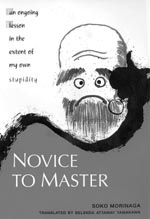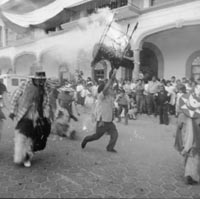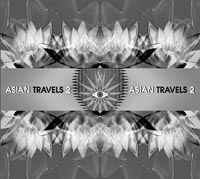The Path of Practice: A Woman's Book of Ayurvedic Healing
Bri Maya Tiwari
Ballantine 2000
 I wish I could read this book aloud to cancer sufferers.
Written as part memoir, part how-to guide, The Path of
Practice is a conversational, self-described "course
in healing and in living." Bri Maya maintains that "all
pain is a reminder that we have strayed from the natural
rhythms of life," and this book acts as a guiding light
to bring us back.
I wish I could read this book aloud to cancer sufferers.
Written as part memoir, part how-to guide, The Path of
Practice is a conversational, self-described "course
in healing and in living." Bri Maya maintains that "all
pain is a reminder that we have strayed from the natural
rhythms of life," and this book acts as a guiding light
to bring us back.
My fascination with The Path of Practice took hold in the chapter on Bri Maya's personal ordeal with ovarian cancer. After fighting a two-and-a-half-year battle with operations and allopathic treatments, while simultaneously building a fast-paced career as a New York fashion designer, she retreated to the wintry woods of Vermont to die alone.
In that Vermont cabin, Bri Maya reconnected with her Indian roots of self-sustainment by baking Indian breads, sifting grains and grinding masalas. She spent six months immersed in journaling, meditation and prayers, and when she emerged from her retreat the cancer that had pervaded her vital organs had gone into remission. Bri Maya continued learning about the Vedas, reconnecting with Divine Mother, and disseminating her knowledge. She founded and runs the Wise Earth School of Ayurveda, and a charity, called Mother Om Mission, to reunite at-risk communities with the universe's natural rhythms.
Bri Maya has delved into a lifetime of experience and boiled it down into The Path of Practice,
briefly but precisely explaining the key principles of sadhana, mantra, mudra, meditation,
pranayama, chakras, ancestral legacies, cosmic sound and silence, doshas and cycles of the moon.
Peppered with personal examples and appropriately chosen quotes from Vedic lore, this book is an
excellent primer or reference book for those who feel drawn to reconnect with innate natural rhythms
in their daily lives.
The chapters on "Sound medicine and spirit healing" and "The inner sound of the human voice" were of
particular interest to me. Tejas, or soul vibration, "makes cosmic sound audible and produces our
inner powers of transformation, our inner voice and intuition." She explains chanting exercises,
prayers and mantras, and stresses the power of vibration and periods of silence. As I practised the
Sanskrit chants, I serendipitously learned that the vibration will scare my kittens away from scratching
up the rugeureka!
This book is a valuable cross-section of practices that facilitate a deeper connection with universal
rhythms. Bri Maya's prose is lulling, accessible and entirely readable for the Ayurvedic novice, with
enough comprehensive content to satisfy seasoned practitioners.
Tracey Peever
back to top
Novice to Master: An Ongoing Lesson in the Extent of My Own Stupidity
Soko Morinaga, Belenda Attaway Yamakawa, trans.
Wisdom Publications 2002
 Soko Morinaga has offered a gift to those who are interested
in engaging in the practice of Zen. In Novice to Master:
An Ongoing Lesson in the Extent of My Own Stupidity,
Morinaga writes of his life leading up to his first encounter
with his first teacher, Zuigan Roshi, his years as a novice
monk, his monastic training and his role as a Rinzai Zen
master.
Soko Morinaga has offered a gift to those who are interested
in engaging in the practice of Zen. In Novice to Master:
An Ongoing Lesson in the Extent of My Own Stupidity,
Morinaga writes of his life leading up to his first encounter
with his first teacher, Zuigan Roshi, his years as a novice
monk, his monastic training and his role as a Rinzai Zen
master.
This book, with its quirky title, follows on the heels of a rash of books written in the mid-1990s,
such as American Zen by a Guy Who Tried It (Steve Sanfield, Larkspur Press 1994); Thank
You and OK!: An American Zen Failure in Japan (David Chadwick, Penguin/Arkana 1994); and Ambivalent
Zen: One Man's Adventures on the Dharma Path (Lawrence Shainberg, Vintage 1995). Morinaga points out
that "his own stupidity" does not refer to some innate quality but to "the false impressions which I
have cleverly stockpiled, layer upon layer, in my imagination."
To read Novice to Master one need not be familiar with Zen terms and Buddhist concepts. Morinaga,
employing examples from his own life, and from those of his students, his fellow monks and his
teacher, paints vivid and poignant vignettes of Zen or "birth and death" experience.
Morinaga talks of his relationship with Zuigan Roshi as a novice monk and as a training monk. His master's every word seems to be accompanied by anger, outrage or condescension, but Morinaga understands that his master "administers strictness with a deep prayer that the disciple will be able to carry through."
This teaching style of a Rinzai Zen master resounded in me completely, having studied for the past twenty-two years with such a master. My teacher, who was born in 1907, entered a monastery at the age of fourteen, has been teaching for fifty years (forty of those in the West) and continues in his strong and razor-sharp manner at ninety-five years of age. My training has had very much the same flavour expressed by Morinaga about his years as a novice and training monk.
The last two chapters follow Miss Okamoto, a lay disciple who dedicated her life from the age of forty to the care of Morinaga's teacher Zuigan Roshi, until his death. The utter compassion and skill with which Morinaga teaches Miss Okamoto is simply portrayed.
Myokyo Judith McLean
back to top
The Healing Forces of Music: History, Theory and Practice
Randall McClellan, Ph.D.
Amity House 1988
 Because our ear bones vibrate from the time before we are
born until we die, what we hear and how we hear are important.
Sound can add to the quality of our life and the life of
the planet. It's as if the universe is one big orchestra
and every vibration contributes to the music. By adding
to the harmony of the music, we can add to universal health.
Because our ear bones vibrate from the time before we are
born until we die, what we hear and how we hear are important.
Sound can add to the quality of our life and the life of
the planet. It's as if the universe is one big orchestra
and every vibration contributes to the music. By adding
to the harmony of the music, we can add to universal health.
In The Healing Forces of Music, McClellan explains the basis of sound in scientific terms and shows how sound has been used in various times and cultures for healing. He demonstrates many principles for understanding our own inner resonance, and how to connect with the power within to heal.
McClellan shows how our voice unites body, mind and spirit, and has properties
that can increase our sensitivity to internal resonance and healing. Voice can
also help remove obstaclessuch as emotional stress and negative mental attitudesthat
make our energy stagnant. Music can also be used in healing to quiet the patient, to help
concentration and to facilitate the expression of emotions. McClellan presents a variety of
techniques for working with sound and breath, from the use of relaxation to chanting vowels and ancient mantras.
"The first requirement of learning the process of healing is to experience the effect of various pitches on your own body." Finding your own natural voice or note is very therapeutic. McClellan tells a story of an old Armenian man who played one note on his cello day after day. His family, driven to distraction by the sound, told him that other musicians played different notes and created melodies. The old man replied that all the others were still searching for "the right note" whereas he had already found it.
The discipline of music can influence us spiritually and create a meditative atmosphere. "The slower the rate individual sound events pass through our consciousness and the greater the periods of silence between them, the slower our sense of time becomes. We may experience a sense of timelessness." In a time-stressed world, focusing on mantras and breath can give us an experience of stillness and tranquility that we can bring into our daily life to create a healthy, relaxed perspective.
The Healing Forces of Music gives a reassuring look at the potential of sound and music for creating a state of well-being. It made me want to learn more and try out my own voice in all its variations.
Swami Radhananda
back to top
Nuevo
Kronos Quartet
Nonesuch Records 2002
| click here to listen |  |
 1992. I remember the day I first heard the album Pieces of Africa by a group called Kronos Quartet.
In my head, I can still conjure up the sound of the CD's first track: a modest, running African percussion,
joined by the climbing melodies of the string ensemble (two violins, viola, cello). This collaboration between
seven African composer-performers and a North American string quartet taught me something remarkable: the
upper-class tradition of a string quartet had somehow lost its upper-classness, while undeniably maintaining
its integrity. I remember listening to it loudly, repeatedlyand I remember that the music seemed to carry
sunlight within it.
1992. I remember the day I first heard the album Pieces of Africa by a group called Kronos Quartet.
In my head, I can still conjure up the sound of the CD's first track: a modest, running African percussion,
joined by the climbing melodies of the string ensemble (two violins, viola, cello). This collaboration between
seven African composer-performers and a North American string quartet taught me something remarkable: the
upper-class tradition of a string quartet had somehow lost its upper-classness, while undeniably maintaining
its integrity. I remember listening to it loudly, repeatedlyand I remember that the music seemed to carry
sunlight within it.
2002. I'm listening to the new Mexico-themed album by Kronos Quartet, titled Nuevo, (although it could
be titled Pieces of Mexico). Nuevo is a journey across the last hundred years of Mexican soundscape. It's
crazy. Beautiful. Delicate. Compassionate. Playful. The album is extraordinarily diverse. It begins with a
majestic Mexican dance, followed by swaying, mourning strings of the second song. The third song bounces.
In the fourth, the violins become fiddles joined by rolling yodels. Halfway through the album, I am listening
to a hazy atmosphere of various strings gently layered over a raw, though soft, Mexican voice. Some tracks
are the most solidly pretty music I've heard in months. The album continues its much varied voyage
over the colours of Mexico, building from calm to dramatic, taking several abrupt and playful breaksthen
concludes with a dance remix by Mexican DJ Plankton Man.
For thirty years, Kronos Quartet has been known internationally for experimentation and a unique artistic vision.
Kronos artistic director David Harrington says, "I've always wanted the string quartet to be vital, and energetic,
and alive, and cool, and not afraid to kick ass and be absolutely beautiful and ugly if it has to be. But it
has to be expressive of life. To tell the story with grace and humour and depth. And to tell the whole story,
if possible."
I like how Kronos Quartet creates an interesting juxtaposition and sharing of cultures.
Although a string quartet represents an educated, wealthy, white tradition, this is
not an imperialistic collaboration. The album is so obviously and solely the result of
shared enthusiasms and respect for art, for audio and for different cultures. Nuevo is a celebration. And, to me, it represents all that is good in world community and in art (crazy, beautiful, delicate, compassionate, playful).
Emrys Damon Miller
back to top
Riva/Rottura
Polmo Polpo
Audi Sensa 2002
| click here to listen |  |
Wearing the albatross of music education, I have the tendency to intellectualize,
analyze and deconstruct music that I listen to. But when I am listening to Polmo Polpo something
different happens: I just start listening. My mind stops trying to piece together how the sounds
were made and the music becomes music again.
Sandro Perri, a trained jazz guitar player, has been making electronic music under the name Polmo
Polpo for three years. He released his fourth album in March 2002 on his own label, Audi Sensa.
Like his previous albums, Riva/Rottura was produced as a limited edition vinyl-only run of 500
copies, and Perri silkscreened every album cover by hand.
Perri creates warmly textured music with various instruments, including filtered drum samples,
slide guitar and double bass. Riva/Rottura feels more like a dream state than anything, like
a slow-motion underwater scene, warm and reflective.
Side A: Riva. I put on the vinyl, the needle slides into the groove. First a washy intro sounds
and the beat drops in. Then a liquid hiss like the ocean fills in the background, the looping
slide guitar melodies start, and I lose my self into the watery world of Polmo Polpo. I find myself
swimming in my subconscious, floating in a muffled world with the sun coming down in streams
through the surface of the water. The double bass pulses throughout like bubbles.
Ambient electronic music, especially the minimal techno scene, has taken off on an international
scale. Polmo Polpo, hailing from Toronto, has his music lumped into this category, but in reality
his music is in a category of his own. Could you really call this techno? The sounds are more
organic than what usually comes out of the computers of techno musicians. I can feel that this music comes from someone, a human, a person with a soul.
Side B: Rottura. Now I am in a submarine. What is it about the aquatic theme? It works so well. Sounds delaying and ricocheting around the metal body of the submerged capsule. Sounds that were once recognizable and have now surpassed simple analysis. They have been combined to create something more. Something new every time I listen to this music. Layer upon layer. So many stories buried. Notes that were once a guitar are now soaring like gulls. I feel uprooted, and this is when I realize the music has become music once again.
Andrew Wedman
back to top
Asian Travels II
Various artists
Six Degrees Records 2002
| click here to listen |  |
 Thanks to technological advances, travel is now more accessible than ever before, not only
physically, but mentally and spiritually as well. The Internet allows instant access to
remote corners of the Earth, and the emergence of yoga in the Western world has facilitated
the inner journeys of millions. All of this represents shrinking world boundaries, which, in
turn, create a dynamic expansion of interest in other cultures.
Thanks to technological advances, travel is now more accessible than ever before, not only
physically, but mentally and spiritually as well. The Internet allows instant access to
remote corners of the Earth, and the emergence of yoga in the Western world has facilitated
the inner journeys of millions. All of this represents shrinking world boundaries, which, in
turn, create a dynamic expansion of interest in other cultures.
Music benefits tremendously from cultural curiosity. A cross-fertilization of styles and genres
meld into one progressive entity, picking up whatever sounds it can along the way. While purists
may consider this dangerous to traditional forms of music, albums such as Asian Travels II challenge
their criticism with graceful resonance.
A collection of ten tracks fusing classical instrumentation from the South Asian diaspora with modern
electronica, Asian Travels II is an intimate walk through a surreal subterfuge of sitars, tablas and
computerized rhythms. This marriage of electronic and traditional music was unavoidable. One can only
wonder if the innovators of today were the same people who first fashioned drums from trees and animal
hide, replacing the organic rhythm of handclaps and thigh slaps.
Asian Travels II explores the evolving dance scene springing from worlds old and new. Flutes and timely
synthesizers float effortlessly against the more rooted backbeats, fusing celestial and earthy tones,
connected to sky and ground alike. This quality permits a comfortable balance, a perpetual segue
between calmness of mind and awareness of body.
Musicians such as Brooklyn-based Karsh Kale and global traveler DJ Cheb I Sabbah contribute
to this futurism. Their consistent use of tablasKale being a seasoned veteran of this instrumentlayered
amid roving drumbeats and hallucinogenic downtempo rhythms afford imaginative discourse between ear and spirit.
I recently saw Sabbah masterfully join East and West, mixing Hindi hip-hop overtop Mary J. Blige (to an enthused
audience reaction).
Yoga is a comprehensive system of spiritual and physical arts. In various forms of Vedic
philosophy, chanting represents a dialogue between speaker and Divine energy, creating a
circular music linking the two into one eternal continuum. In his book Language and Myth,
Joseph Cassier puts forth the idea that language and mythology initiate the same process:
an attempt to describe our experiences for others to understand. Sound and language, then,
are exchanges between humankind and nature, a direct unity amid perceived fragments.
The practice of yoga aligns the individual with cosmic nature; it abides not by human laws
but by the seasons themselves. Pythagoras introduced his "Music of the Spheres" in an attempt
to describe a form of music governing celestial bodies, positioning sound as the true ruler of
existence. Quieting the mind through breath tunes us into these eternal harmonies, as we
reconnect with internal schematics and rewire our personal circuitry.
For practitioners of yoga and fans of music, Asian Travels II is a necessity for modern living.
As global beat fusion overtakes dance floors on a worldwide scale, the audiences comprise people of all
faiths and cultures, and being surrounded by diverse individuals dancing to the same rhythm is an uplifting
experience. When a classical sitar line bleeds through Euro-breakbeats, two distinct styles have found common
ground, sounding as if destined for such companionship.
Working and caravanning constantly around New York City, I've been afforded numerous opportunities to partake
in customs of many diverse cultures. This is the evolution of individualism finding solace in the comfort of
anotherand we're relearning what our kindergarten teachers told us: sharing is good.
Six Degrees Records has long promoted such communion. Their Traveler series, of which
Asian Travels II is a sampling, engages in the epic quest of unifying music that has,
thus far, remained apart. Asian Travels II brings the traditional cadence of not-so-distant
lands to the technological drive of modern culture. With this, there is serenity in chaos,
an ancient balance to our transient futurism.
Derek Beres
back to top